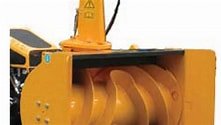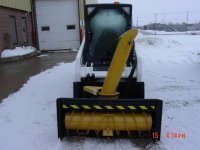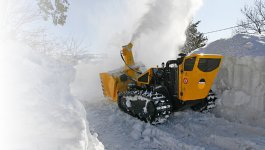Single stage snow blowers are not obscure implements, they were mounted on lawn and garden tractors first long before the 2 stage snow blowers came into use.
Single stage snow throwers require a great deal more steel to construct them and cost more to build and fell out of favor when they started using the 2 stage units because the 2 stage homeowner units were made with thinner steel. Some 2 stage units were made very well and many were junk and still are.
In 1968 when we moved to the burbs-5 miles from the city limits the house came with a beautiful original International Harvester Corporation 12 horse Cub Cadet lawn and garden tractor with head lights, 4 link ladder snow chains, a homemade cab and a I.H.C. single stage snow blower mounted on it. I believe it had a Kohler engine too.
That lawn and garden tractor had power and then some as it used a small V belt to spin the right angle one to one grease filled bevel gearbox that was spinning the drive sprocket and #40 roller chain that spun the driven sprocket that was attached to the snow blower rotor.
I am going from memory here but the snow blower rotor was 12 or 13 inches in diameter and the solid steel tube that the auger flights were welded to was 6 inches in diameter. I believe at high idle/wide open throttle it spun at 600 revolutions per minute under no load.
The lawn and garden tractor had a hydrostatic transmission with the forward and reverse lever on the dash and the rear wheels were bolted to the rear axle shafts like my Wheel horse 244 hydrostatic tractor that I want to get going on again.
The weight of the single stage snow blower and its mounting frame and the weight of the lawn and garden tractor itself was enough to create the adhesion needed to sprint up and down our 20% grade asphalt driveway and get rid of any snow fall. I wish pop had not traded it in on a IHC cub low boy with a 4-cylinder I.H.C. water cooled engine, mower, plow and no chains as that only made it harder to clean the driveway as it could barely get out of its own way even with chains.
With a single stage snow blower at wide open throttle you are cutting into it as fast as the conditions will allow and you are throwing the snow and ice chunks as far as possible as fast as possible through the chute and spout and the tractor is not pushing against a great deal of load.
If your dealing with a lot of ice covered ground to clear snow adding beet juice or windshield washer fluid to the rear tires even with chains is just added insurance for working in snow.
I have to put chains on my Garden Way snow blower and fill the tires because the mess they make with the huge amount of salt they use creates a huge amount of slush that I have to get rid of to be able to use my broken up asphalt driveway.
I have the same issue with the cleaning the second driveway even though it is sod right up to the ditch markers.
The old Canadian made Reist single stage series 1000 snow throwers design was perfect with its
augers flights occupying the half the volume of rotor housing and the other half being the snow blower
rotors steel tube that is supported by open flange bearings.
The former Reist Series 1000, 2000 and 3000? snow throwers were designed as a single stage snow thrower that could be used either as a rear 540 RPM PTO powered snow thrower which if desired could also be used as a hydraulic driven skid steer mounted snow thrower by simply switching out the three-point hitch mount for the SSQA plate, removing the gear box and installing the hydraulic motor for the snow thrower drive cross shaft plus the high flow hydraulic motor hoses.
The snow thrower rotor rotated up to 700 RPM with the sprockets as installed and could be slowed down with a larger pair of sprockets, the sprockets were secured with locking rings that were secured with Socket Head Bolts (Allen Bolts) in taper lock rings to keep them in place and could be removed to change sprockets with simple hand tools and a torque wrench to assure the Allen bolts were torqued properly.
The space between the rotor flights edges could be adjusted to move the rotor closer to the housing to reduce plugging and prevent ice and snow build up behind the rotor.
The 2 pictures I have uploaded show the hydraulic drive 48 and 54 inch single stage design that Reist made and made very well.
1. the snow blower rotor diameter is 13 inches if my memory is right and the steel tube the flights are welded to is
2. the snow blower rotor has 4 center paddles welded 90 degrees apart to discharge the snow at a high rate of discharge
3. the snow thrower chute is long to reduce snow dust spillage while clearing
4. The angle of the snow thrower flighting is shallow being about 15 degrees allowing the snow blower rotor to clear snow pack efficiently allowing the snow blower to operate at a high rate of speed


